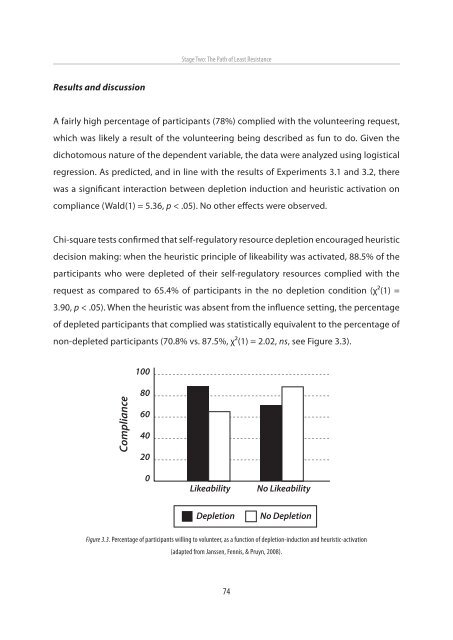Chapter 1 - Universiteit Twente
Chapter 1 - Universiteit Twente
Chapter 1 - Universiteit Twente
You also want an ePaper? Increase the reach of your titles
YUMPU automatically turns print PDFs into web optimized ePapers that Google loves.
Results and discussion<br />
Stage Two: The Path of Least Resistance<br />
A fairly high percentage of participants (78%) complied with the volunteering request,<br />
which was likely a result of the volunteering being described as fun to do. Given the<br />
dichotomous nature of the dependent variable, the data were analyzed using logistical<br />
regression. As predicted, and in line with the results of Experiments 3.1 and 3.2, there<br />
was a significant interaction between depletion induction and heuristic activation on<br />
compliance (Wald(1) = 5.36, p < .05). No other effects were observed.<br />
Chi-square tests confirmed that self-regulatory resource depletion encouraged heuristic<br />
decision making: when the heuristic principle of likeability was activated, 88.5% of the<br />
participants who were depleted of their self-regulatory resources complied with the<br />
request as compared to 65.4% of participants in the no depletion condition (χ²(1) =<br />
3.90, p < .05). When the heuristic was absent from the influence setting, the percentage<br />
of depleted participants that complied was statistically equivalent to the percentage of<br />
non-depleted participants (70.8% vs. 87.5%, χ²(1) = 2.02, ns, see Figure 3.3).<br />
Compliance<br />
100<br />
80<br />
60<br />
40<br />
20<br />
0<br />
Likeability No Likeability<br />
Depletion No Depletion<br />
Figure 3.3. Percentage of participants willing to volunteer, as a function of depletion-induction and heuristic-activation<br />
(adapted from Janssen, Fennis, & Pruyn, 2008).<br />
74
















